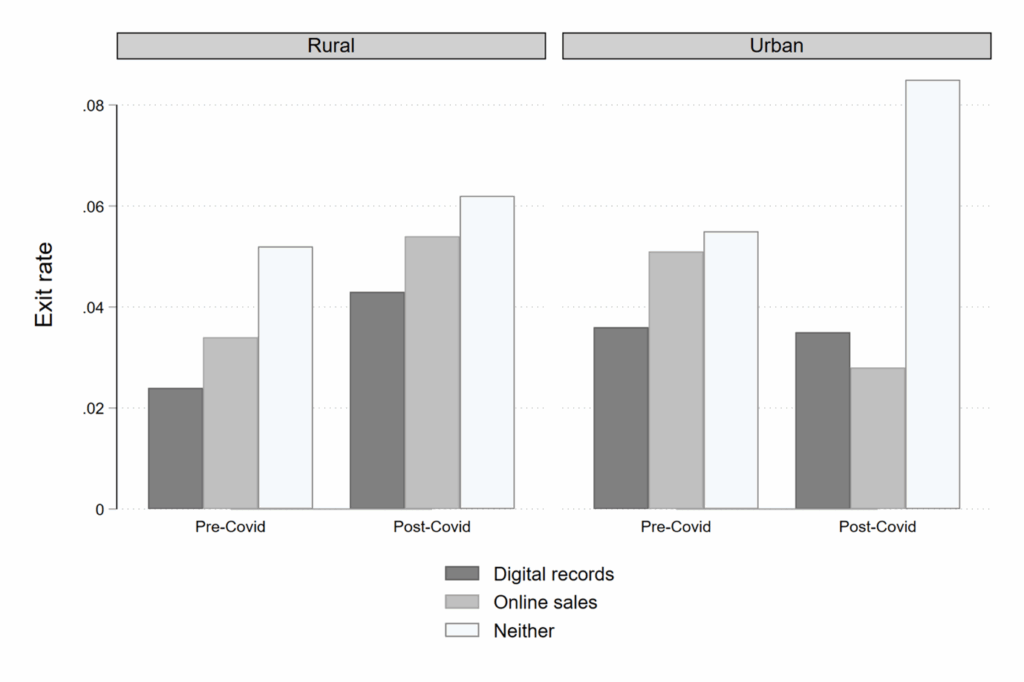In the UK, the Covid-19 pandemic was marked by strong spatial differences in the strictness and duration of government-mandated lockdowns. The average number of weeks spent in strict lockdown was 50% higher in urban local authorities than in rural ones. The marked increase in working from home that ensued, largely facilitated by the use of digital tools, led many to expect the “death of cities”, while rural areas would be less affected by the pandemic. However, this has failed to materialise, just as the ‘death of distance’ that was predicted with the advent of the digital age (Friedman, 2005). In contrast, in terms of economic dynamism, innovation and earnings, the digital age has coincided with increasing divides between urban and rural areas in many countries.
Because Small and Medium-sized Enterprises (SMEs) were particularly vulnerable to the succession of lockdowns, social distancing rules and restrictions on businesses, and because they were also less likely to have adopted digital tools before the pandemic (Massini et al., 2025), we investigated in a recent study the role that the early digitalisation of SMEs plays in boosting their chances of survival during the pandemic years.
We find that digital tools – particularly, the ability to sell online – became much more important in helping businesses continue operating from 2020 onwards. However, this is only the case for SMEs located in urban areas. In rural settings, SMEs that had started using digital tools prior to the pandemic faced the same probability of going out of business during the pandemic as SMEs that had not. Looking forward, this calls for a cautious and place-based SME digitalisation strategy.

Note: The figure shows the average annual exit rate for small and medium-sized businesses in urban and rural areas before and after the pandemic, separately for businesses that were using digital record-keeping technology, online sales technology, and neither of these technologies. Digitalisation variables are captured before the start of the pandemic in the UK. This shows that although exit rates increased after 2020 for all types of firms in rural areas and for urban firms without digital tools, in urban areas, firms with digital record keeping did not experience higher exit rates, and firms with online sales saw a drop in exit rates.
Early digitalisation and pandemic business survival
In our study, we considered two digital tools: digital record-keeping tools, such as the use of a digital bookkeeping platform or software, and online sales, either through a business’s own website or a third party such as Amazon or social media. Importantly, we measured the use of these technologies before the pandemic hit, giving us a measure of digitalisation and preparedness that is independent of any ad-hoc investments in remote working technologies businesses made as a response to the lockdowns.
We found interesting shifts in the role these digital technologies played post-pandemic. While digital record-keeping was already associated with a lower probability of business exit before the pandemic, businesses with an online sales channel were actually more likely to exit. However, this changed sharply with the onset of the pandemic. From 2020 onwards, SMEs that already had either digital record-keeping or online sales were less likely to exit the market than SMEs using neither of these tools.
Yet, when we considered urban and rural firms separately, we found that these effects only held for firms in urban areas. In rural areas, the protective effect of digital record-keeping disappeared after 2020, and digital sales were not associated with a difference in exit rates either pre- or post-pandemic. Contrary to expectations, the increased importance of digital tools during the pandemic years did not benefit rural SMEs.
Investing in digital versus direct government support
As our data provides information on whether firms used government support schemes during the pandemic, we can compare the role of digitalisation as a resilience tool against government support to help businesses survive. We find that for urban businesses, early digitalisation was actually more instrumental in preventing exit than government support. In rural areas, on the other hand, government support was more effective in helping SMEs survive (see figure 2).

Note: The figure shows British SMEs’ actual and predicted exit rates during the Covid-19 pandemic, 2020-2022. This indicates that in rural areas, removing Covid support from all firms would substantially increase the exit rate from 5% to 6%, whilst applying Covid support to all firms would substantially lower it, from 5% to 2%. The predicted effects on urban firms’ exit rates are considerably lower.
Supporting SME digitalisation is therefore an effective policy option to increase the resilience of businesses in urban areas. For rural SMEs, however, direct financial support to businesses in distress appears to be the more effective crisis response if the objective is to limit business closures.
Rural barriers to the effective use of digital tools
Important barriers to the use of digital tools to facilitate resilience, therefore, seem to be in place in rural areas. One possibility is that businesses in rural areas lack the in-house skills to be able to convert their existing digital inputs into tools that boost their competitiveness and market survival. Rural SMEs may also suffer from the relative lack of professional services in rural areas compared to cities. These service firms may have offered decisive advice to increase their ability to implement digital solutions effectively. Finally, though the relative lack of high-speed broadband in rural areas might explain our results, our investigations indicate that this isn’t the case.
As the UK Government is considering the recommendations of the SME Digital Adoption Taskforce, it will be important to bear in mind the urban-rural divide in the ability of SMEs to make the most of their digital tools.
Offline Reference:
Connect with the Authors

Sabine D’Costa is a Senior Lecturer in Economics at the University of Westminster. She is also an external member of the Centre for Globalisation Research at Queen Mary University of London. She is currently an Associate Editor of Regional Studies, Regional Science. Her research interests are in economic geography, urban and regional economics. She has produced research on agglomeration economies, the urban wage premium, regional disparities in firm productivity and survival, regional growth and the labour market impacts of transport investments. She has previously worked at the London School of Economics and Queen Mary University of London and consulted for the NGO and public sector, such as the OECD and Transport for Greater Manchester.
![]() : Sabine D’Costa
: Sabine D’Costa ![]() : 0000-0002-7143-993X
: 0000-0002-7143-993X

Carolin Ioramashvili is an Assistant Professor in Innovation Policy at the Science Policy Research Unit, University of Sussex. She is also a visiting fellow in the Department of Geography & Environment at the London School of Economics. She is currently serving as an early-career editor at Spatial Economic Analysis. Her research interests are in the geography of innovation, regional labour markets and local economic growth. She also has a strong interest in policy evaluation and was a British Academy Innovation Fellow with the Evaluation Task Force in the UK Cabinet Office. She has previously worked at City-REDI, the University of Birmingham and in the private sector as a policy consultant.
![]() : Carolin Ioramashvili
: Carolin Ioramashvili ![]() : Iroamashvili.bsky.social
: Iroamashvili.bsky.social ![]() : 0000-0002-7776-2105
: 0000-0002-7776-2105